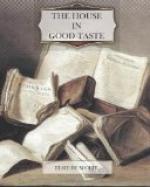I once saw a little serving-maid wearing a calico gown, black crosses on a white ground, and I was so enchanted with the cool crispness of it that I had a glazed wall paper made in the same design. I have used it in bedrooms, and in bathrooms, always with admirable effect. One can imagine a girl making a Pierrot and Pierrette room for herself, given whitewashed walls, white woodwork, and white painted furniture. An ordinary white cotton printed with large black polka dots would make delightful curtains, chair-cushions, and so forth. The rug might be woven of black and white rags, or might be one of those woven from the old homespun coverlet patterns.
The landscape papers that were so popular in the New England and Southern houses three generations ago were very wonderful when they were used in hallways, with graceful stairs and white woodwork, but they were distressing when used in living-rooms. It is all very well to cover the walls of your hall with a hand-painted paper, or a landscape, or a foliage paper, because you get only an impressionistic idea of a hall—you don’t loiter there. But papers of large design are out of place in rooms where pictures and books are used. If there is anything more dreadful than a busy “parlor” paper, with scrolls that tantalize or flowers that demand to be counted, I have yet to encounter it.
Remember, above all things that your walls must be beautiful in themselves. They must be plain and quiet, ready to receive sincere things, but quite good enough to get along without pictures if necessary. A wall that is broken into beautiful spaces and covered with a soft creamy paint, or paper, or grasscloth, is good enough for any room. It may be broken with lighting fixtures, and it is finished.
[Illustration: THE SCHEME OF THIS ROOM GREW FROM THE JARS ON THE MANTEL]
VI
THE EFFECTIVE USE OF COLOR
What a joyous thing is color! How influenced we all are by it, even if we are unconscious of how our sense of restfulness has been brought about. Certain colors are antagonistic to each of us, and I think we should try to learn just what colors are most sympathetic to our own individual emotions, and then make the best of them.




